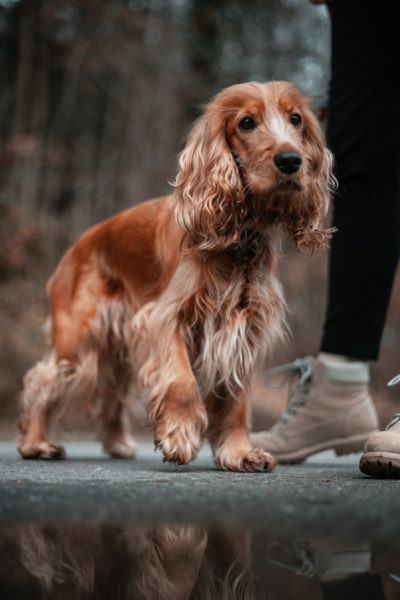
For many years, it enthusiastically hunted woodcocks. Originally from Spain, spread mainly to England. For centuries, the English used them in net hunting, where the cocker and game were trapped together.
Description
- Small, well-built, strong, and elegant dog
- Long, dry, distinguished head
- Powerful jaws with well-developed lips
- Flat, thick, and silky coat with fine texture
- Height at the withers: 38 to 41 cm for males; 37 to 40 cm for females
- Weight: 1 to 13 kg
- Average lifespan: 15 years
Distant origins
Legend says that like all spaniels, the Cocker Spaniel was born from the crossbreeding of French dogs from the Crusades with Eastern Greyhounds. However, it was created through the crossbreeding of different types of Spaniels, including the smaller variety. The primitive form of the Cocker Spaniel was quite different from the current type, and it was often confused with other Spaniel categories that were longer and lower on their legs. The breed gained popularity in Scotland, where it was used for hunting woodcocks. Scottish hunters preferred cockers with white markings, making them more visible in dense covers and underbrush.
Very British dog
In English, “woodcock” is “cocker,” and the Cocker Spaniel excelled in hunting woodcocks in thickets, which is believed to be the origin of its name. Moreover, “to cock” in English means to surprise the game. The Cocker Spaniel we know today comes from Wales and Devonshire. In France, it was warmly welcomed, and the breed was officially recognized in 1895. The Spaniel Club was founded in 1897, but it’s impossible to trace a pedigree authentic to more than a hundred years. Currently, Cocker Spaniels are more widespread than their American counterparts.
Wagging tail
The Cocker Spaniel’s tail is in constant motion, indicating its natural activity and cheerfulness. The tail should follow the line of the back and be carried down or level, never elevated, which would be a serious fault. The tail is usually docked during the puppy’s first days, and there is barely any bleeding. This mini-amputation is part of the elegance of the Cocker Spaniel.
Physical characteristics
- General characteristics: A well-balanced, robust, yet elegant dog.
- Head: Stop placed midway between the tip of the nose and the occiput. Well-developed and well-defined skull, broad between the ears.
- Eyes: Hazel or brown in color, lively and bright gaze.
- Ears: Broadly rounded and set low at the level of the eyes. Recognizable by their long, silky, and curly hair.
- Muzzle: Well wide nose allowing excellent scenting ability. Powerful and well-aligned jaws with no undershot. Lower incisors fitting precisely inside the upper incisors.
- Neck: Moderately long, well-muscled, powerful. Cocker’s neck is gracefully arched. No dewlap.
- Body: Compact build, giving an impression of strength. Ample, deep chest without being too wide. Well-sprung ribs. Short and wide loins, with a gently arched topline leading to a docked tail.
- Legs: Well-boned front legs, with oblique and refined shoulders. Straight and short limbs, suitable for hunting support. Wide and muscular hindquarters.
- Feet: Firm and round “cat feet” type.
- Tail: Set lower than the topline. Cocker carries its tail horizontally or below the back line, never raised excessively. The tail may be docked, but not excessively, maintaining overall proportions.
- Coat: Flat, silky, and extremely soft to the touch. Never wavy or curly. The body is amply covered with well-furnished and long hair.
- Color: A wide variety of coat colors, but white markings are only allowed on the chest.
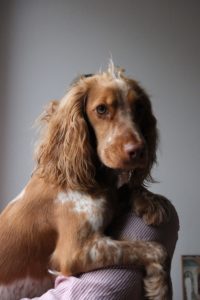
Temper
Positive traits
- Cheerful
- Assertive personality
- Flexible in character if well-guided
- Affectionate
- Intelligent
- Incredibly loyal
- Playful
Negative traits
- Stubborn
- Sensitive
- Occasionally disobedient
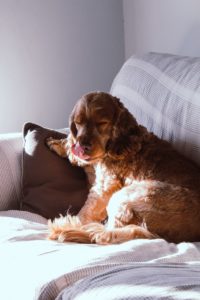
Demanding
More or less sensitive, sometimes stubborn, the Cocker Spaniel needs some discipline regardless of its merits and enthusiasm. But beware! It obeys only if it feels loved; then, it’s eager to please. The happy Cocker constantly wags its tail, showing its devotion and quickly seeking its owner’s company. Few dogs are as pleasant, affectionate, and charming as this breed. Those who have owned a Cocker Spaniel appreciate it enormously. People who, for any reason, are separated from their Cocker dearly miss its presence.
An intuitive mind
The Cocker Spaniel knows how to make itself interesting. Brilliant and mischievous, its bright gaze is endearing. Always ready to make quick decisions, it acts in its own way, often with originality, guided by its marvelous instincts.
A perfect flusher
Obeying without being servile, the Cocker Spaniel understands its master’s intention and guesses what’s expected of it. It’s deeply attached to its owner and has well-established hunting skills. Thanks to its size, it can access various places, making it a perfect flusher. It’s not a pointing dog but a “finder” that must methodically explore its territory, zigzagging right and left to ensure nothing is missed. It excels at flushing rabbits and directing them towards the hunter.
Too impulsive
To prevent the Cocker from getting carried away in its quest for game, the master must enforce perfect obedience. Otherwise, instead of being a valuable collaborator, it might become a troublemaker, making its presence inconvenient. When it detects a scent, it should head in the direction from which the scent came, flush the animal, and most importantly, not pursue it.
A good retriever
The Cocker Spaniel willingly goes into water, but its moderate size can make things challenging in the reeds, compared to taller-legged breeds. Nevertheless, it has excellent endurance and energy combined with an unyielding courage to flush out game and promptly retrieve it after it’s been shot. It can even retrieve the game in the order it was shot. During nesting season, be careful as the Cocker will likely want to disturb the nesting birds on the ground. In such cases, be firm with your commands.
Is the male sometimes grumpy?
Female Cockers are generally more affectionate and gentler than males. They adapt more easily to their owner’s demands. Males are more active and occasionally a bit grumpy. However, their reputation for having a bad temperament comes from the breed’s overproduction in the 1960s, without strict temperament selection.
With children
The Cocker Spaniel is just the right height to play with small children. A quick complicity forms between the Cocker and the children, and mutual trust becomes the norm. They speak the same language and play together. Any teasing is quickly forgotten when sharing a treat. When a baby arrives in the house, introduce the Cocker to the newborn. This way, it will associate the newcomer with a family member and will be protective of them. Some say the Cocker can be jealous, but it’s not true; it just needs to feel respected!
Overall, it has a positive health outlook! Its only real weakness is its ears.
The ears, almost dragging on the ground, are the Cocker’s weak point as they collect dirt during walks in woods and fields. Poorly ventilated, they become a breeding ground for infections. To prevent issues, the inner ear and ear canal should be plucked. Also, avoid letting them dip in water each time they drink; instead, use a high, narrow bowl to prevent this.
Daily routine
- Voracious eater
- Tends to be gluttonous
- Requires at least three walks per day if living in the city
- Easily prone to wandering
- Tends to put dirty paws on visitors’ trousers
- Pulls on the leash during walks as it wants to explore everything
- Purchase price: moderate to high
The Cocker Spaniel needs to expend energy, and every walk becomes a joyful event. If you forget, it will remind you, unless it decides to go alone; then, don’t hold back while it’s still raring to go. It’s full of health, voracious, and fearless… don’t hesitate to exercise it while it still has energy.
Although primarily a hunting dog, the Cocker Spaniel is also a popular companion breed due to its grace and elegance.
Diet
As a puppy, it should have three meals a day. Meat is the foundation of its diet, accompanied by pasta, rice, or cooked vegetables, and occasionally a raw egg mixed in. At six months, milk is eliminated, and it should have two meals a day. Veal bones, especially the tender bone of the hock, are recommended. As for the quantity of food, no more than 400 grams per day, with at least 100 grams of meat. Occasionally, cooked, boneless fish can be part of its menu. Avoid fat, small pointy bones, starchy foods, and especially cabbage!
Living space
The Cocker Spaniel can have its cushion and bed in an apartment. However, the ideal scenario is having a fenced space where it can roam freely, sniff around, roll on the lawn, and play with a ball, something it enjoys greatly. Thanks to its fine coat, it dries quickly, so you can take it to the woods even on rainy days. Train it to come back when called; otherwise, its hunting instinct will take over.
Health
Regular and frequent walks, taking your Cocker out for one to two hours a day, and bringing it to the countryside as often as possible, will keep it in great shape. You’ll notice its lively and shiny eyes and its brilliant coat. Otherwise, it may develop eczema. Watch out for grass awns that can penetrate between the toes, the nose, and especially the ears.
As it ages, the Cocker may experience urinary issues and kidney paralysis. It’s also prone to obesity and cataracts.
Grooming
Grooming should be done with a brush, comb, and fingers. Straighten any hairs that stand up as tufts and comb the ears carefully. Gently untangle the fringes. The tail, measuring 8 to 10 cm in length, should be clear at the base, clean, and without fringes. Baths should not be too frequent; once a month is sufficient! For particularly hairy Cockers, a visit to the groomer every three or four months is recommended. Also, the lower lip folds easily trap debris, so they should be regularly cleaned to avoid inflammation (cheilitis).
 Is it disciplined?
Is it disciplined?
Not at first. It needs training; otherwise, it will run around, jump on beds, chew chair legs, roll in mud, and then on your carpets. It can be quite a handful! Correct it firmly but also show that you love it, rewarding it when it behaves well.

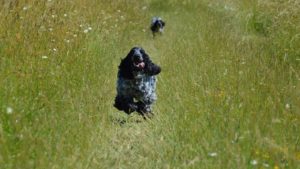
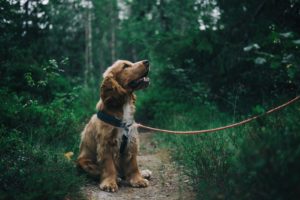 Is it disciplined?
Is it disciplined?